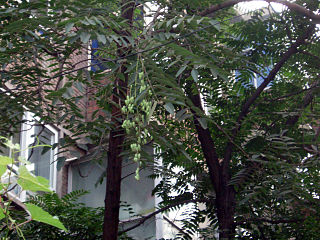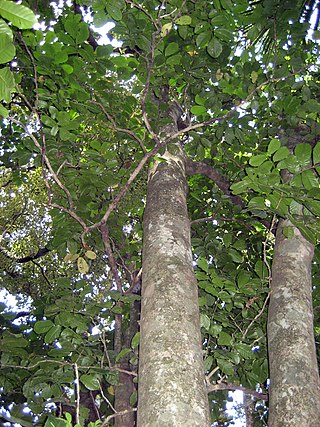
Mahogany is a straight-grained, reddish-brown timber of three tropical hardwood species of the genus Swietenia, indigenous to the Americas and part of the pantropical chinaberry family, Meliaceae. Mahogany is used commercially for a wide variety of goods, due to its coloring and durable nature. It is naturally found within the Americas, but has also been imported to plantations across Asia and Oceania. The mahogany trade may have begun as early as the 16th century and flourished in the 17th and 18th centuries. In certain countries, mahogany is considered an invasive species.

Meliaceae, the mahogany family, is a flowering plant family of mostly trees and shrubs in the order Sapindales.

Celtis is a genus of about 60–70 species of deciduous trees, commonly known as hackberries or nettle trees, in the hemp family Cannabaceae. It has a cosmopolitan distribution.
Mahogany refers to dark-colored wood from various types of tree.

Stewartia is a genus of 8-20 species of flowering plants in the family Theaceae, related to Camellia. Most of the species are native to eastern Asia in China, Japan, Korea, Laos, Myanmar, Thailand, and Vietnam, with two in southeast North America, from Virginia and Kentucky south to Florida and Louisiana.

Dysoxylum is a genus of rainforest trees and shrubs in the flowering plant family Meliaceae. About 34 species are recognised in the genus, distributed from India and southern China, through southeast Asia to New Guinea, Solomon Islands, and Australia. The name Dysoxylum derives from the Greek word ‘Dys’ meaning "bad" referring to "ill-smelling" and ‘Xylon’ meaning "wood".

Toona ciliata is a forest tree in the mahogany family which grows throughout South Asia from Afghanistan to Papua New Guinea and Australia.

Toona sinensis, commonly called Chinese mahogany, Chinese cedar, Chinese toon, beef and onion plant, or red toon is a species of Toona native to eastern and southeastern Asia, ranging from northern Korean peninsula through most of eastern, central, and southwestern China, in Nepal, northeastern India, Burma (Myanmar), Thailand, and even present in Malaysia and western Indonesia.

Xylocarpus is a genus of plants in the mahogany family Meliaceae. It contains 3 described species, all of which are mangroves. The native range of the genus is the coasts of the Indian Ocean, Southeast Asia and the western Pacific Ocean. It is the only mangrove genus in Meliaceae.

Didymocheton is a genus of flowering plants in the family Meliaceae. It includes 41 species which range from eastern India through Indochina and southern China to Malesia, Papuasia, eastern Australia, New Zealand, and the South Pacific.
Goniocheton is a genus of flowering plants in the family Meliaceae. It includes four species which range from Indochina to south-central China, Taiwan, Malesia, Papuasia, Vanuatu, and Queensland.
Prasoxylon is a genus of flowering plants in the family Meliaceae. It includes seven species which range from Nepal and eastern India through Indochina to southern China, Taiwan, Malesia, Sri Lanka, Papuasia, and Queensland.

Toona sureni is a species of tree in the mahogany family. It is native to South Asia, Indochina, Malesia, China, and Papua New Guinea. It is commonly known as the suren toon, surian, limpaga, iron redwood or the red cedar. It is also known as the Indonesian mahogany or the Vietnamese mahogany. The species is a valuable timber tree.
Azadirachta excelsa, commonly known as sentang, is a tree in the mahogany family Meliaceae. The specific epithet excelsa is from the Latin meaning 'lofty'.

Chisocheton is a genus of trees in the family Meliaceae. The genus name comes from the Greek schizos and chiton meaning "split tunic", referring to the lobed staminal tube of C. patens. Their range is from India and tropical China, throughout Malesia and south to New South Wales and Vanuatu.
Chisocheton pentandrus is a tree in the family Meliaceae. The specific epithet pentandrus is from the Greek meaning 'five man', referring to the five stamens of each flower.

Goniocheton arborescens, commonly known in Australia as Mossman mahogany, is a small tree in the mahogany family Meliaceae. It is native to rainforests of Malesia, Papuasia, Queensland and nearby islands.

Epicharis parasitica, commonly known as yellow mahogany, is a species of tree in the family Meliaceae; it grows primarily in tropical rainforests and is native to Taiwan, parts of Malesia, Papuasia, and northeast Queensland.

Didymocheton gaudichaudianus, commonly known as ivory mahogany, is a species of rainforest tree in the family Meliaceae, native to Malesia, Papuasia, Queensland, and some southwest Pacific islands.
Dysoxylum acutangulum is a species of flowering plant in the mahogany family, Meliaceae. It is a tree native to Peninsular Thailand, Malesia, New Guinea and the Solomon Islands, and the Northern Territory and Queensland in Australia.















